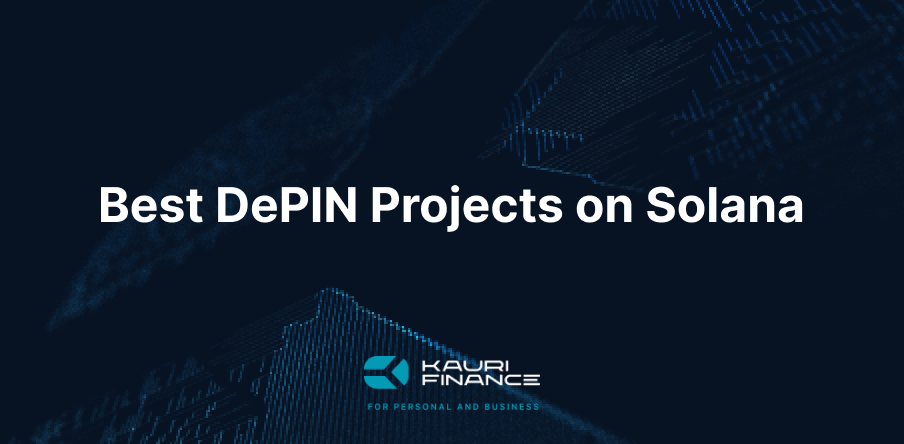
Best DePIN Projects on Solana: Pioneering Decentralized Physical Infrastructure
- Understanding DePIN and Its Role in the Solana Ecosystem
- Top DePIN Projects Driving Innovation on Solana
- Helium Network: Revolutionizing Wireless Infrastructure
- Render Network: Decentralizing GPU Computing Power
- Akash Network: Decentralized Cloud Computing Infrastructure
- The Future of DePIN Projects on Solana
- Getting Involved: How to Participate in Solana DePIN Projects
- Conclusion: The Impact of DePIN on Solana's Growth and Adoption

Picture a future where your home router powers a vast, decentralized wireless network, or your idle GPU renders CGI for Hollywood blockbusters. This isn't science fiction—it's the reality DePIN projects are creating on Solana's high-performance blockchain. These ventures aren't merely disrupting traditional models; they're redefining our interaction with technology and physical infrastructure.
As we delve into the world of DePIN projects on Solana, let's first understand the fundamental concepts driving this innovative ecosystem.
Understanding DePIN and Its Role in the Solana Ecosystem
Decentralized Physical Infrastructure Networks (DePIN) are revolutionizing real-world challenges by leveraging Solana's high-performance blockchain. These projects bridge digital innovation and tangible assets, creating robust, scalable solutions that rival centralized models.
Solana's swift transactions and low fees provide the ideal foundation for DePIN projects to thrive, enabling decentralized networks that respond to real-world demands with unprecedented efficiency. From wireless communication to cloud computing, these initiatives reimagine shared resources and collaborative infrastructure.
-
Enhanced resilience through distributed architecture
-
Democratized access to infrastructure services
-
Incentivized participation via tokenomics
-
Reduced costs and improved data privacy
-
Scalable networks adapting to growing demand
By aligning individual incentives with network growth, DePIN projects foster self-sustaining ecosystems. This innovative approach challenges traditional models and paves the way for a more inclusive, efficient future.
Now that we grasp the basics of DePIN and its significance in the Solana ecosystem, let's explore the top projects that are pushing the boundaries of decentralized infrastructure.
Top DePIN Projects Driving Innovation on Solana
In Solana's DePIN landscape, innovation flourishes where blockchain meets real-world infrastructure. Our selection criteria spotlight projects with groundbreaking use cases, robust tokenomics, and tangible impact on decentralized networks. These ventures leverage Solana's high-performance capabilities to redefine physical possibilities.
From wireless communication to cloud computing, these pioneers are reshaping industries by incentivizing network participation and democratizing resource access. Their disruptive potential fosters self-sustaining ecosystems, marking them as true blockchain innovators. As we explore these projects, we'll uncover solutions to current challenges and glimpse the future of our increasingly decentralized world.
Helium Network: Revolutionizing Wireless Infrastructure
The Helium Network, a pioneer in decentralized wireless infrastructure, has found a new home on Solana's high-performance blockchain. This strategic migration supercharges Helium's mission to democratize connectivity, leveraging Solana's lightning-fast transactions and minimal fees to create a robust, community-driven wireless ecosystem.
Helium's innovative approach incentivizes individuals to deploy and maintain hotspots, forming a vast network of decentralized wireless coverage. The dual-token model, comprising HNT and MOBILE, elegantly balances network growth with user rewards. HNT serves as the primary value token, while MOBILE fuels network usage, creating a self-sustaining economic loop that drives adoption and expansion.
Use cases span from IoT device connectivity to providing internet access in underserved areas. The network's seamless integration with existing infrastructure positions it as a formidable challenger to traditional telecom giants.
"Helium on Solana isn't just about faster transactions; it's reimagining wireless connectivity. We're cultivating a movement that empowers communities to shape their digital future, with over 1 million hotspots deployed globally."
As we move from wireless infrastructure to computing power, let's explore another innovative DePIN project reshaping the digital landscape.
Render Network: Decentralizing GPU Computing Power
The Render Network exemplifies Solana's potential for revolutionizing computational power distribution. By harnessing idle GPUs globally, this platform creates a decentralized rendering powerhouse, challenging traditional CGI and AI processing paradigms. It democratizes access to high-performance computing, allowing creators to tap into a worldwide GPU resource pool.
Leveraging Solana's swift transactions, Render Network orchestrates complex tasks across its distributed network, dramatically reducing rendering times and costs. This opens doors for independent artists and small studios to compete with industry giants. The native RNDR token facilitates seamless transactions, rewarding participation and fueling innovation.
As AI and metaverse technologies advance, Render Network's growth prospects soar. Its scalability positions it as a cornerstone for future computational demands, from real-time ray tracing to training large language models. By decentralizing GPU power, it optimizes resource utilization and fosters a more equitable digital landscape.
Having explored GPU computing, let's shift our focus to another critical aspect of decentralized infrastructure: cloud computing.
Akash Network: Decentralized Cloud Computing Infrastructure
Akash Network is revolutionizing cloud computing on Solana, offering a decentralized alternative that challenges traditional providers. By harnessing underutilized computing resources worldwide, Akash creates a robust, cost-effective infrastructure that democratizes access to cloud services. Its unique approach leverages Solana's high-performance blockchain to facilitate seamless transactions and resource allocation.
Unlike centralized giants, Akash's distributed model enhances security and resilience, mitigating single points of failure. The network's dynamic pricing mechanism ensures competitive rates, often undercutting established providers by up to 85%. This cost-efficiency opens doors for developers and businesses previously priced out of high-performance computing solutions.
-
Unparalleled scalability through global resource pooling
-
Enhanced data sovereignty and privacy protection
-
Reduced environmental impact via optimized resource utilization
-
Seamless integration with existing DevOps tools and workflows
-
Community-driven innovation fostering rapid feature development
-
Decentralized governance ensuring equitable decision-making
Akash's impact extends beyond cost savings, potentially reshaping the entire cloud computing landscape. By decentralizing infrastructure, it paves the way for a more resilient, accessible, and innovative digital ecosystem, aligning perfectly with Solana's vision for a decentralized future.
With a clear understanding of Akash Network's potential, let's take a broader look at what the future holds for DePIN projects on Solana.
The Future of DePIN Projects on Solana
As Solana's DePIN ecosystem matures, we're witnessing a paradigm shift in decentralized infrastructure. Projects like Helium, Render Network, and Akash are just the tip of the iceberg, promising a symbiotic relationship between physical assets and blockchain technology that drives unprecedented efficiency and accessibility.
Industry analysts predict exponential growth for DePIN projects on Solana, with market capitalization potentially surpassing $50 billion by 2028. This surge is fueled by increasing demand for decentralized services and Solana's scalability advantages. Let's compare key metrics of our featured projects:
|
Project |
Market Cap (USD) |
Token Price (USD) |
Network Adoption |
Growth Potential |
|
Helium |
1.2B |
7.85 |
1.2M+ Hotspots |
High: IoT expansion |
|
Render Network |
750M |
2.30 |
50K+ GPUs |
Very High: AI/ML demand |
|
Akash Network |
300M |
1.75 |
100K+ Deployments |
Moderate: Cloud market |
Emerging trends suggest a convergence of DePIN with AI and IoT technologies, potentially revolutionizing smart cities and Industry 4.0 initiatives. We anticipate a surge in cross-chain interoperability, allowing DePIN projects to leverage Solana's speed while tapping into other blockchain ecosystems. The next frontier? Tokenized real-world assets integrated with DePIN, enabling fractional ownership of infrastructure and democratizing investment opportunities.
Now that we've explored the future landscape of DePIN on Solana, let's discuss how you can actively participate in this exciting ecosystem.
Getting Involved: How to Participate in Solana DePIN Projects
Embarking on your DePIN journey with Solana opens doors to a revolutionary digital frontier. To dive into this ecosystem, follow these strategic steps:
-
Set up a Solana-compatible wallet like Phantom or Solflare, prioritizing robust security measures
-
Acquire SOL tokens through reputable exchanges, essential for network interactions
-
Conduct thorough research on DePIN projects, analyzing their unique value propositions and market potential
-
Participate in token sales or acquire project-specific tokens on decentralized exchanges, diversifying your portfolio
-
Contribute resources such as computing power or network bandwidth to chosen projects, actively shaping the network's growth
-
Stake tokens to bolster network security and earn passive rewards, aligning your interests with the project's success
-
Engage with project communities to stay informed and influence governance decisions, becoming a true stakeholder
While DePIN projects offer exciting opportunities, they come with inherent risks. Market volatility, regulatory uncertainties, and technological challenges can impact returns. However, the potential rewards are substantial. Early adopters may benefit from token appreciation, network incentives, and the satisfaction of shaping tomorrow's infrastructure.
Remember, due diligence is crucial. Assess each project's team credentials, technological innovation, and tokenomics before committing resources. By participating thoughtfully, you're not just investing—you're actively building the decentralized future of physical infrastructure.
As we've seen, DePIN projects on Solana are not just reshaping infrastructure; they're redefining the very fabric of our digital world. Let's reflect on their broader impact and what it means for Solana's future.
Conclusion: The Impact of DePIN on Solana's Growth and Adoption
DePIN projects on Solana are revolutionizing decentralized infrastructure. Helium's wireless innovation, Render Network's GPU power, and Akash's cloud computing showcase this ecosystem's transformative potential. These ventures are building a more inclusive digital future on Solana's high-performance blockchain.
Market projections suggest a $50 billion valuation for DePIN projects by 2028, driving broader Solana adoption. This growth cements Solana's position in Web3. As DePIN converges with AI, IoT, and tokenized assets, unprecedented opportunities emerge. Your engagement today could shape tomorrow's decentralized landscape, making vigilance in this rapidly evolving space crucial.
